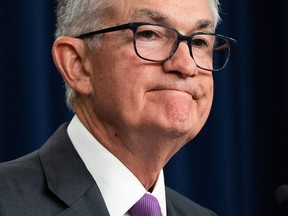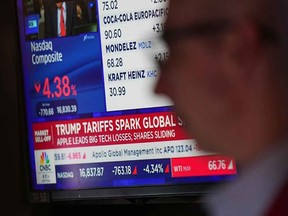History shows once the Fed goes 5 months without hiking after a tightening cycle, the cycle is over
Article content
Well, I have to say that I liked what I saw last week. Jerome Powell’s body language at the Federal Open Market Committee meeting represented a fairly big shift on two fronts: acknowledging that policy was restrictive and that there was still a ton of tightening in the pipeline we haven’t seen yet. From my lens, it is no longer going to be camouflaged by raging fiscal stimulus.
Advertisement 2
Article content
The United States employment report on Nov. 3 showed the first cracks on the labour market front. Never mind that nonfarm payrolls came in light at 150,000 in October versus the 180,000 consensus estimate, and that this was the second softest print since December 2020. When you count in the downward revisions, the contraction in the workweek and the skew from the birth-death model, it was equivalent to the headline coming down 528,000 last month.
Article content
The household survey was not far off, as the market collapsed 348,000 in October. That includes the additional 218,000 who were working part time for economic reasons and the 205,000 surge in the number of people taking more than one job to make ends meet — that is a classic countercyclical indicator.
Even with a modest dip in the labour force participation rate, the headline unemployment rate ticked up to 3.9 per cent, the highest since January 2022. It is now up a half-point from the early 2023 low of 3.4 per cent, and that, indeed, is a recessionary signal (it is the change, not the level, that determines the recession call).
Article content
Advertisement 3
Article content
On average, going back to 1960, whenever the jobless rate has gone up half a point from the cycle trough, the recession is just getting underway. The broader U-6 measure of joblessness rose to 7.2 per cent from seven per cent, up 0.7 percentage points from the cycle low posted in December 2022. It reflects a notable loosening up of the labour market. This is why wages were so benign, at 0.2 per cent month over month in October, and with the three-month trend now running at an annual rate of 3.2 per cent — consistent with the Fed’s two per cent inflation objective.
The aggregate hours-worked index fell 0.3 per cent month over month. This represents total labour input into the economy, and the decline in October was close to a one-in-10 event. The fourth quarter is off to a rough start. The “build-in” for aggregate hours worked is 0.1 per cent. That means productivity is going to have to carry the load this quarter.
On the demand side, auto sales fell 1.2 per cent month over month in October and have been down in three of the past four months (from 15.7 million units at an annualized rate in September to just under 15.5 million in October). The Johnson Redbook survey closed the month with a minus 1.5 per cent month-over-month sequential retail sales decline. It is going to be very interesting to see what the retail sales number reveals when the data comes out on Nov. 15, but something tells me it could be a huge negative surprise — the consensus estimate has already moved to minus 0.5 per cent, but the risk is for an even weaker print.
Advertisement 4
Article content
This brings me to the fourth quarter gross domestic product (GDP) because, last week, the Federal Reserve Bank of Atlanta’s Nowcasting model moved from 2.3 per cent to a stall speed of 1.2 per cent. There is not one word about this anywhere. But when it first moved to five per cent for the third quarter in mid-August, this was what all the anchors at CNBC, Fox Business and Bloomberg were talking about. It’s as if a one-handle on Q4 GDP is something we aren’t supposed to be aware of.
But if that is the number we are talking about at this time in mid-December, then the U.S. Federal Reserve will not be doing anything. And that’s important because it means the last hike was in July, a five-month pause. History shows that once the Fed goes that long without hiking after a tightening cycle, the cycle is over. The next move would be a cut, with the lag from the last hike to the first cut being 10 months on average. That puts the first cut as early as May, or June, which is where the futures market is now leaning.
So, we have all markets now sensing a pause here by the Fed. And in that pause period, bonds and stocks tend to rally together. But nothing does as well as the 30-year Treasury, which traditionally delivers an average total return of nine per cent point to point. That compares to just over a seven per cent return for the S&P 500 and six per cent for both investment-grade and high-yield credit.
Advertisement 5
Article content
Nothing comes close to the long end of the Treasury curve. You get the biggest basis-point rally at the front end as the curve steepens, but the best total return is at the long end, where it more than doubles that and, on average, is 300 basis points superior to the belly of the curve.
Related Stories
The fact that we are seeing a break in wages (also a key feature in the ADP report) is a really big deal. Even before that tame number in the payroll report, the productivity report for the third quarter showed that labour costs deflated 0.8 per cent at an annual rate and cut the year-over-year trend from 5.7 per cent a year ago to 1.9 per cent today. This is a significant downward break in the trend, bringing it close to where it was in the summer of 2020. At the time, that presaged an unexpected round of Fed easing in the second half of the year — and from a 3.7 per cent peak, not a 5.7 per cent peak.
David Rosenberg is founder and president of independent research firm Rosenberg Research & Associates Inc. To receive more of David Rosenberg’s insights and analysis, you can sign up for a complimentary, one-month trial on the Rosenberg Research website.
Article content
The Fed has cause for a pause
2023-11-07 18:48:15





Comments
Postmedia is committed to maintaining a lively but civil forum for discussion and encourage all readers to share their views on our articles. Comments may take up to an hour for moderation before appearing on the site. We ask you to keep your comments relevant and respectful. We have enabled email notifications—you will now receive an email if you receive a reply to your comment, there is an update to a comment thread you follow or if a user you follow comments. Visit our Community Guidelines for more information and details on how to adjust your email settings.